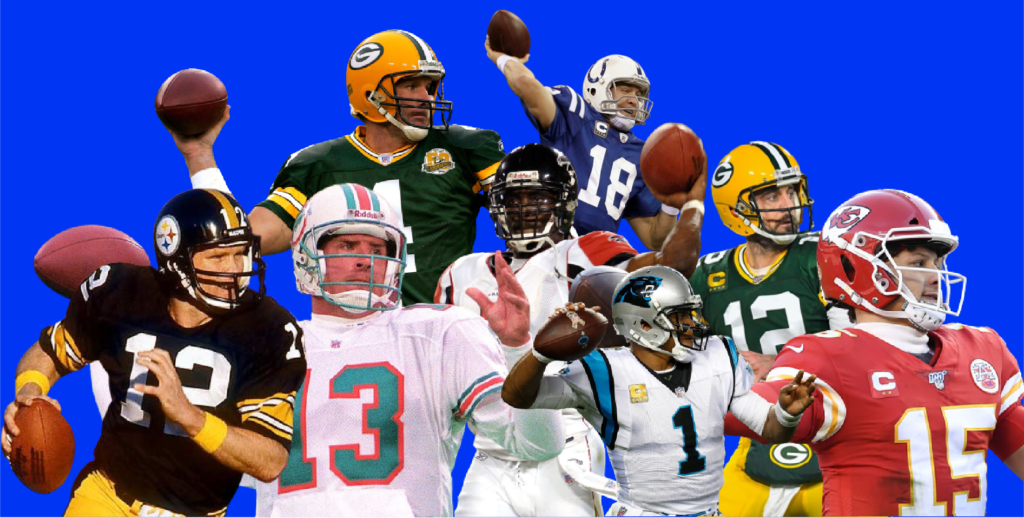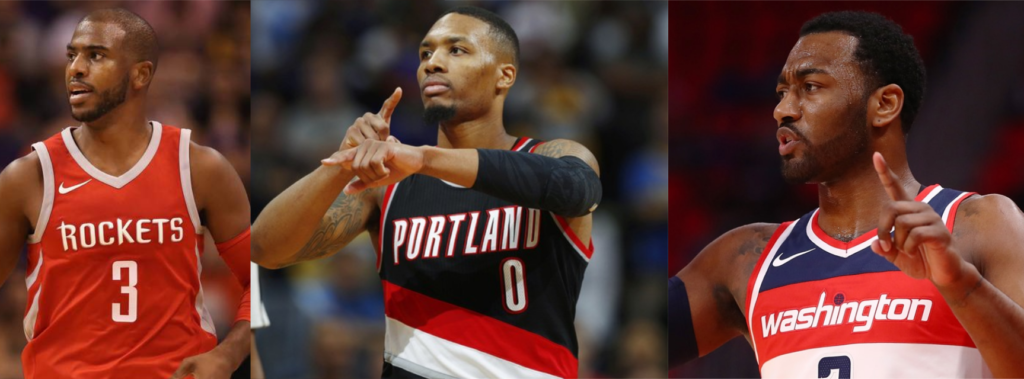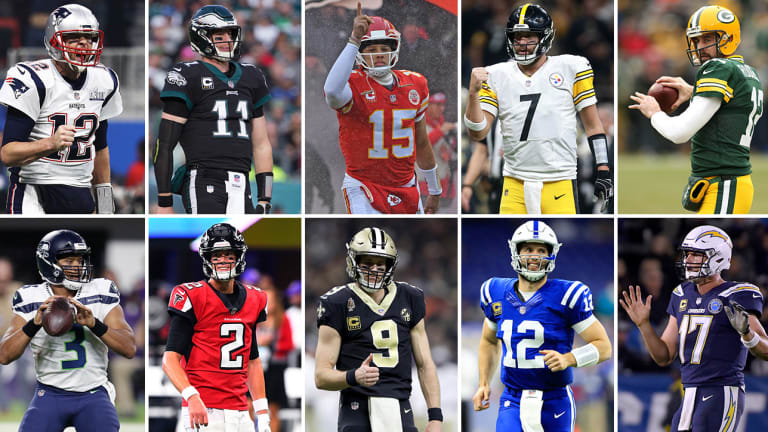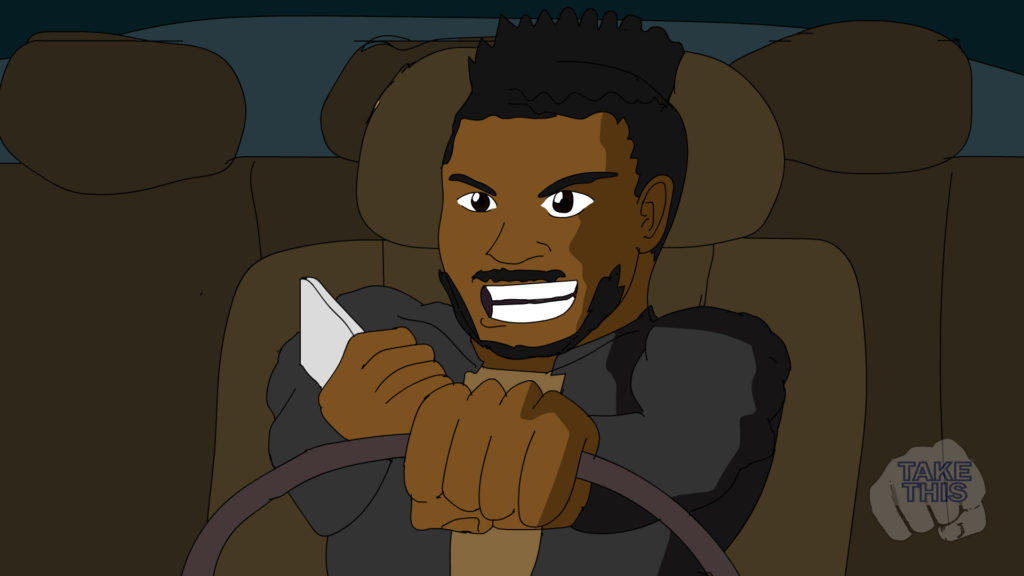When watching sports for long enough, you will being to realize that you are watching the same players over and over again. You realize that you have already seen this player or that player before. This is generally because most humans are really similar. If you know the traits and circumstances, we really are predictable as a species!
There have been many NFL Quarterbacks, but a lot of them can largely fit into a few select categories or archetypes based on some combination of their physical talents and their corresponding playstyle, and their similar career success and similar circumstances that come with these playstyles. This article is going to list and describe these QB archetypes, their tendencies, give examples, and explain their strengths and weaknesses.
Roles such as “Game Manager” are not included. This is because anyone, regardless of skillset or physical talents can technically manage a game.
Similarly, “field general” is not included by itself, because again, technically anyone of these QBs can be a field general (make an audible, dropback, process the defense, throw to the open guy, and repeat). Gunslingers, limited passers, etc.
Note: Unless stated otherwise, it is assumed the QB has decent mobility. This is because most QB’s typically do have decent mobility of varying degrees.
Note 2: This article is mostly going to highlight examples that were either successful, or notable.
Backyard Football QB/Gunslinger

Notable examples: Brett Favre, Patrick Mahomes, John Elway, Carson Wentz, Tony Romo (early in his career)
These guys typically have crazy strong arms, they are mobile, and just have the type of sheer physical talent, athleticism, craftiness, and wizardry that makes GM’s swoon and fans deify.
They are gold standard. They are the guys that teams salivate over. They are usually picked within the first 2 rounds.
They have a cannon for an arm – absurd arm strength. They are hard to tackle, because they are good runners, they have a big build, and have really solid speed.
They usually win a ring, as their sheer talent often makes them a magnet for teams that already have good coaches and skill-position pieces that need a great QB to put them over the top (think of the Packers trading for Favre, or the Chiefs trading up to get Mahomes), and their skillset also gives them a good floor and great foundation to build around. Their talent allows them to make great plays, and their fearlessness allows them to break through. They also do at times have a good processor – they may not always read defenses the best, but they can spot open guys and throw it to them quickly.
The combination of a strong arm, great mobility, and a fast processor makes them look like the best in the league at times, and they have a penitent for heroic, mind-blowing plays.
As a result, these guys almost always elevate their teams when they arrive. The Packers became an immediate perennial playoff team when Favre arrived. The Chiefs became a perennial Super Bowl contender with Mahomes. Elway was able to get Denver to Super Bowls without much strong offensive support or a great offensive scheme.
However, their fearlessness can be a vice – especially as time passes by in their careers: with such guts comes the prospect of playing too much hero ball, which can lead to them throwing picks or not being discipline or patient enough in certain moments, especially against great defenses in the playoffs. This is part of why Favre did not return to the Super Bowl after 98, and one can argue we saw a sign of it in the 2021 AFC Championship game between the Chiefs and Bengals, which Mahomes. This is why these guys often win 1 or 2 rings, but not any afterwards. They are gamers. The sheer physical talent is a blessing and a curse. They can get too loose with their mechanics, play hero-ball too much, and not always maintain their poise against complex defensive looks, instead aiming to make a great play.
This is also why they aren’t often consistently leading the league in efficiency stats. Sometimes, they can have some high interception seasons.
Strong Arm Precision Passer
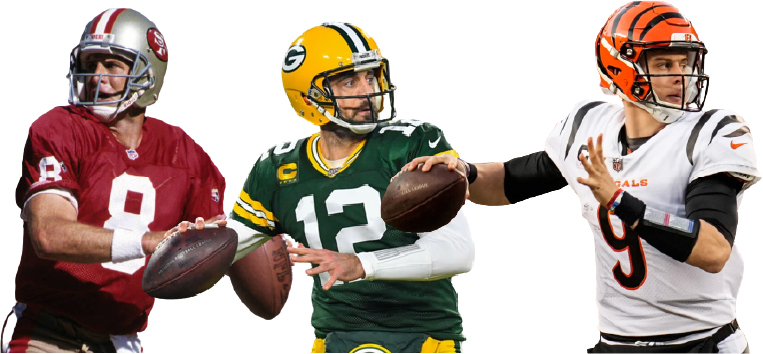
Notable Examples: Steve Young, Aaron Rodgers, Joe Burrow
These guys are very similar to the gunslingers above – they generally have strong arms, great mobility, and the ability to create magical plays out of nothing.
Where they differ is that the sheer raw arm strength and craftiness is very slightly traded in exchange for more accuracy and more controlled play. Rodgers and Steve Young have both set records for passer rating efficiency in their eras for this reason. Rodgers has one of the best TD:INT ratios ever. These guys do not throw as many interceptions as the Gunslinger and typically have better stats, as they are more accurate and make better decisions. Although, their success does not really differ, either. They all are generally good at reading defenses and exploiting mismatches, which is also why their efficiency numbers are good.
They throw a REALLY pretty ball. Because of their balance of controlled play but great physical talent, they typically are among the best in the league, and can still peak as high as the gunslingers, and can still make and win Super Bowls. This efficient can play can be their demise, however. In moments where a defense prevents them from exploiting mismatches, they won’t always have the radical plays gunslingers have – they won’t throw picks or anything though. More importantly, they won’t always feel comfortable throwing into coverage at times. They may simply end up being ineffective, sometimes too conservative, leaving plays on the field, and sometimes taking bad sacks, or throwing the ball away. Their stats will typically look good even in playoff losses, but when you watch, you’ll notice they have stretches where they “retreat”/
Precision Passer
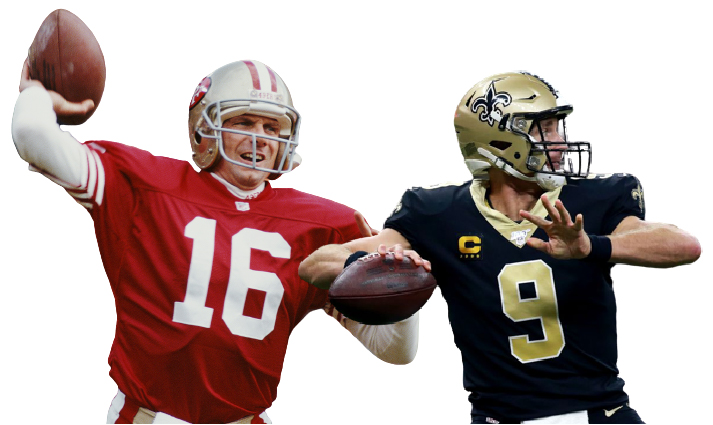
Notable Examples: Joe Montana, Drew Brees, Brock Purdy, Kenny Anderson
These guys are similar to the guys above, but they don’t have the really strong arms that allows them to make highlight-worthy throws at the rate the guys above can. But they are still nimble and deceptively mobile, and are masterful in the offenses they run. The lack of absurd physical arm talent or speed is why these guys tend to not be top 5 picks or anything, but they are overall still well-regarded coming into the draft. These can also still put together MVP-caliber seasons. They aren’t celebrated for their physical attributes during their time in the league, but they don’t lack any NFL caliber attributes.

Perhaps the most defining trait these guys have is there ability to throw with great timing and anticipation. They have great sense at anticipating where or when guys will be open, and can deliver a really accurate ball in stride that can lead to great YAC.
However, the problem with these guys is that their preference for anticipatory throws can often be their Achilles heel against really good zone defenses – because again, their arm strength isn’t top-of-the-league level great. They definitely have good arms, and can throw with some great zip intermediately and can throw deep. But they lack that next level elite arm strength. So they are forced to attempt the timing/anticipation-based throws a little more often than other guys, and that can put them in trouble more than other QBs since they won’t always be able to rifle a pass in zone coverage with the same velocity as other guys – hence their occasional high-interception seasons.
These guys also tend to be clutch, too. Montana was Joe Cool. Brees is top 3 all-time in game-winning drives. And Matt Ryan is also good with game-winning drives, with his nickname being “Matty Ice”.
There’s not much else to say due to their similarity to the guys above.
The Limited Passer

Notable Examples: Virgil Carter, Alex Smith, Chad Pennington (especially post-injury), Colt McCoy, Sam Bradford, Teddy Bridgewater, Mac Jones(?)
These QB’s are generally from the same tree as the guys above, but what makes them worse is that typically, their arms are weaker than the precision passers above. And this matters, because having a mediocre or weak arm limits the types of throws you can make, and the types of throws you will even attempt to make. It also means that things have to be perfect around you. Instead of being able to throw a 35 yard strike off his backfoot to a receiver running a streak route, they’ll have to set their feet and tilt their shoulders to launch the ball, thus requiring their feet to be set, the timing to be perfect, and having the ball sail in the air. As a result of these limitations, these guys are more risk-averse, and play within their means. They’ll throw the short pass well. If they see a Cover 1 defense, and his receiver is running a Go route with a corner trailing him, they can still throw a very pretty-looking deep ball. They try not to do too much, and they take what’s there. This can be a good things sometimes – this often means that their teams will generally be okay! They usually have solid numbers too. They won’t ever lose you a game.
But they won’t often ever win you a game. Because these guys won’t be able to throw into tight windows against great defenses, where you need a QB that can throw a fastball that takes 1.6 seconds to travel 25 yards in the air before the defender can make a play on it. They can’t consistently make higher level throws, like a perfectly timed 25 yard back-shoulder throw where the corner won’t let you get away with throwing it high in the air. Against a good defense, the safety has time to run and intercept the ball because the QB’s pass hanged in the air. This is why these guys often never go far. They still have some of the mobility of the precision passers above, but not enough for to make up for their arm strength. They have a decent understanding of defenses, but again, their limitations as a passer can nullify this, and their smarts are sometimes underwhelming and can’t make up for their arm. It limits the explosiveness and depth of their offenses, which can hurt them in the playoffs. They may also just flat out lack the confidence to make certain throws, and thus appear to be too conservative and risk-averse. And if they have to try and keep up against an elite QB in a shootout, they’ll typically lose – and may even turn it over. They can turn it over, because they may try to make a play – but they lack the sheer physical talent with their arms or legs to make it happen.
Phillip Rivers is unique in that he hasn’t been known for being the poster-boy for a QB with a weak arm, but his arm still isn’t that good, and he shares a lot of the flaws of these limited passers: underwhelming decision-making and processing, inability to consistently be clutch, never peaking high as an MVP candidate, etc.
So as a result, these guys, with a good team, can reliably net you 10-11 wins. But you won’t often see these guys top out at 14 wins, lead a high powered offense, be an MVP candidate, be considered the best QB in the league, and lead a team that is considered the best team in the league.
Stiff Gunslingers

Notable Examples: Kurt Warner, Dan Marino, Drew Bledsoe, Jeff George, Joe Flacco, Matthew Stafford, Jameis Winston, Eli Manning(?)
These Quarterbacks typically have the arm talent and mentality of the aforementioned gunslingers (or at least still have very good arms in their own right), but they do not have the same level of mobility that allows them to make the same types of crazy magical “wow” plays as the gunslingers do. They do those “wow” plays with their arms, exclusively. Sidearm throws, throws off of unconventional angles, etc. are possible with some of these guys. Some of them may not have the wow plays at all, but still have a great arm they are not afraid to use. They are not afraid to throw into coverage, and they generally have the ability to.
I use the word “stiff” – stiff is a little strong, as some of these guys can still move around, but the point is that these guys aren’t really known for their mobility, nor is their ability to move around of any real concern for a defense like it is for the gunslingers and strong arm precision passers.
These guys don’t always peak as high as the more mobile gunslingers do, but their teams still do find success and can make it far, as they have great arm talent and guts to make all the throws needed, so in a year where their team is really good (some blue-chip receivers, strong rushing attack, good defense), as long as they can get the hot hand and be consistent in January, they can even get a ring. But generally, they can still be inefficient at times, and throw interceptions. They are very prone to high interception seasons – on the examples list, Warner, Winston, Eli, Cutler, and Stafford all led league in interceptions in some seasons. Even the great Dan Marino did among his peers. Most of the league-leaders in interceptions tend to be of this mold, followed by the Backyard Football Gunslingers (specifically, the non-good ones). They still have the fearless style of the Backyard Football gunslingers, after all. Because they have cannons for arms, they really want to use it. And similar to the gunslingers, they can have bad habits. They can force passes, stare-down a downfield receiver that they want to sling it to, and may have lapses with their pocket awareness. They’re processing – especially under pressure – isn’t always that good. Their decision making can also be aggressive. They don’t have the great mobility and scrambling or pocket presence to bail them out. With the exception of Dan Marino, this is why their careers can be extremely hot and cold. They can have several years where they don’t even look like good QB (because, a lot of them can have high interception seasons). But in a good year, they can randomly be clutch, and sometimes fit right in with the best QBs in the league, or at least be top 10. This is why the more successful ones (Stafford, Warner, Eli) with the exception of Dan Marino, are always never clear Hall of Fame locks. People debate if they should be in the hall of fame. Often, their career volume stats help them.
But hey? Guess what? There’s a reason why a lot of these dudes have rings. They are willing to be aggressive, and they have the arm strength to make the big boy throws. It’s why many of them have also won playoff games where their defenses gave up over 20 points.
There’s a reason why most of the meme/mid/or even non-elite QBs that have won rings, tend to be of this archetype: Flacco, Foles, Stafford, Eli, etc. If you don’t have a top 5 elite QB, you basically need a guy like this if you want any chance of winning.
Play Extenders/Scramblers

Notable Examples: Fran Tarkenton, Roger Staubach?, Russel Wilson, Deshaun Watson, Kyler Murray
These guys say “hut”, look for the basic reads, and when they’re not there, they will run around in circles and make something out of nothing. These guys don’t always have the crazy arms that the gunslingers have, but they always have really good arms. This is why they are different from gunslingers – gunslingers can roam around, and make any throw from any platform, whether it’s across their body, or even while falling down. Scramblers/play extenders roam around, but then may still need to move around again, and again, to find their spot. This is because they don’t have the crazy arm strength gunslingers have, just regular very good arms.
They may also just take off and run out of bounds. Gunslingers can do that to, but they can find guys downfield and launch it to them with more ease.
These play extenders typically give very high floors – as they have some of the magic that gunslingers do, while still having a good amount of the efficiency and controlled habits that the precision passers do. However, their ceilings aren’t always there, as they sometimes may have some physical limitations. They do not have weak arms like limited passers do, but they don’t have the crazy gunslinger arm. They are not generally very tall or large in build – hence the necessity for them to have to scramble (Wilson and Murray being examples).
Many of them other than Staubach have not won rings though. Staubach did a better job of playing within the offense than these guys did (although Landry was still upset with him at times for going rogue…), and perhaps his height at 6’3 allowed him to make more middle-of-the-field throws that made his team’s offenses harder to stop. After all, Tarkenton, Murray, and Wilson are all 6’0 or shorter.
There is still time to see what Kyler and especially Deshaun can do, however, as their careers are still young.
The Play Deception QB

Notable Examples: Ryan Tannehill, Kirk Cousins, Baker Mayfield, Nick Foles, Dak Prescott, Matt Schaub, Mitchell Trubisky, Jared Goff
These guys are unique. They have good arm talent. They have decent mobility sometimes. They technically can make all the throws, in theory. They are usually top 15 QBs. But, they have trouble consistently putting it altogether, especially against certain defenses. They’re usually not feel comfortable with what they see, and end up turning it over as a result. So they typically need to play in an offense that is built around the deception of the rushing attack and that has a great offensive line. Whether it’s an offense that has an elite running back (so opposing defenses can focus in on the runningback instead of the passing attack), or a team that runs a lot of RPOs, these QB’s need one of these two things to clear things up downfield when they want to throw. These QB’s need offenses that run play action, or that make use of their star running back. The use of the play-fake means there will typically be less defenders downfield, thus allowing them to feel more comfortable to deliver an accurate pass. This is why some of these guys can occasionally have really good-looking statistical seasons. But we usually never hold them in high regard. They rarely go all the way. They have trouble keeping up against good QBs in a shootout, because if they are down in a game, they are forced to pass, and the opposing defense can focus exclusively on stopping the passing attack instead of stopping their elite running back. This happens a lot in the playoffs if the running back is struggling. This then exposes these QBs’ flaws – not staying composed against certain defensive looks, not being consistently accurate enough, and not having the hyper athleticism or processing to make up for it.
These guys typically disappoint in the playoffs as a result, and don’t often win rings. As result of these flaws, these are typically very sensitive to the situations around them – when their teams are really good, they can look like a top 10 QB. When their teams are not
Some of the stiff gunslingers – like Drew Bledsoe – can fit into this group because similar flaws they have.
The Dual Threat

Notable Examples: Lamar Jackson, Michael Vick, Cam Newton, Colin Kaepernick, Randall Cunningham, Marcus Mariota, Tim Tebow
These QBs are guys that defenses have to worry bout them running just as much as they have to worry about their passing. They typically have great overall physical talent – strong arms, and great running speed and agility.
Their running is great:
And again, they typically can throw strikes with a flick of the wrist:
https://www.youtube.com/watch?v=rC0S1swLGMQ
They don’t always have the crazy plays the gunslingers like Favre do, but it’s close enough. They tend to be leaner as well.
As a result of their playstyle, they can occasionally peak really high – be an MVP, lead a team to a first-round-bye, even a Super Bowl – and they also have high floors, as the very nature of their game makes it hard for defenses to adjust to and gameplan – this is especially helpful early in their careers, when they are still getting used to the NFL. Teams like them (and other physically talented, mobile QB variants), because in the event that they aren’t great reading defenses, their dual-threat nature still allows them to compete. But their playstyles often mean that they burn bright, and won’t always last long. A combination of injuries, getting beat up, losing their speed, etc. can limit their effectiveness in both passing and running. They can be solid in reading defenses, but not strong enough to offset the diminished skills. The designed runs – and sometimes, skinny build – can damage their bodies.
Additionally, they may rely too much on the dual-threat game, and thus won’t always push their other skills forward enough, or it may hurt their feel for the game. If they last, they’ usually have to develop and refine their passing ability.
Other unique archetypes:
Some of these guys can’t neatly fit into a box, or there are very few guys who are like them.
“Hybrids/Unicorns” – Gunslinging Field General?

Notable Examples: Terry Bradshaw, Ben Roethlisberger, Josh Allen, Andrew Luck, Justin Herbert, Donovan McNabb
These guys can best be described “hybrids”, or unicorns. They have some of the traits you love about each QB. They have the some of the abilities and big physical build of a mobile gunslinger, but they also have the ability to be a field general that will patiently read and dissect a defense with timing-based throws. They can even do other things – Josh Allen, for example, can do designed runs like a dual-threat QB, and Roethlisberger can resemble a pure scrambler.
Luck can run to the line of scrimmage and throw a pristine 45 yard laser while being tackled from behind, and without setting his feet.
And in another way, Herbert can run up, and then somehow magically set his mechanics perfectly before throwing it.
All these guys, as mentioned before, can still call audibles, read defenses, and have a good measure of control within the offense.
They have a little bit less of the crafty backyard football throws that the backyard football gunslingers have, but still make up for it with their generally more surgical play. When they are at their best, they can make some extremely accurate throws, because their mechanics are more consistent, and they still have very strong arms. They’re offensive production is typically good, but they can still throw interceptions like the gunslingers, and are not always the best QB in the league in a given year. They often tend to have a lot of pass attempts in a given game – don’t be surprised to see them have a game where they throw 50 times, more than once. This is because their team’s generally have faith in them. There’s a lot on their plate though, as a result. Their teams may not run the ball enough, or their teams may flat out not run the ball that well. It just happens like that, with these guys…. They can have their fair number of games where a defense can take away certain routes, and they’ll have trouble adjusting. Some of this is because of the amount of responsibility on them, but still. They can also throw some interceptions, and don’t often have high efficiency numbers. Also, their versatility (especially as it pertains to their physicality) often means they’ll be running a lot, and it means defenses are gonna have to hit them harder. This often means that these hybrids can get beat up a lot after some 10 years.
However, they are still perennial top 5 or top 10 guys, are still great for prolonged periods of time, and usually end up having very successful careers.
In short, it’s like they were basically made in a lab. It’s like someone wanted to make the perfect QB, and took Cam Newton’s body, John Elway’s arm, Peyton’s mind, and a little bit of Favre’s craftiness, and mixed it together. They are to the NFL what a 6’10 guard that can shoot 3-pointers and defend big men are to the NBA.
Audible Field Generals
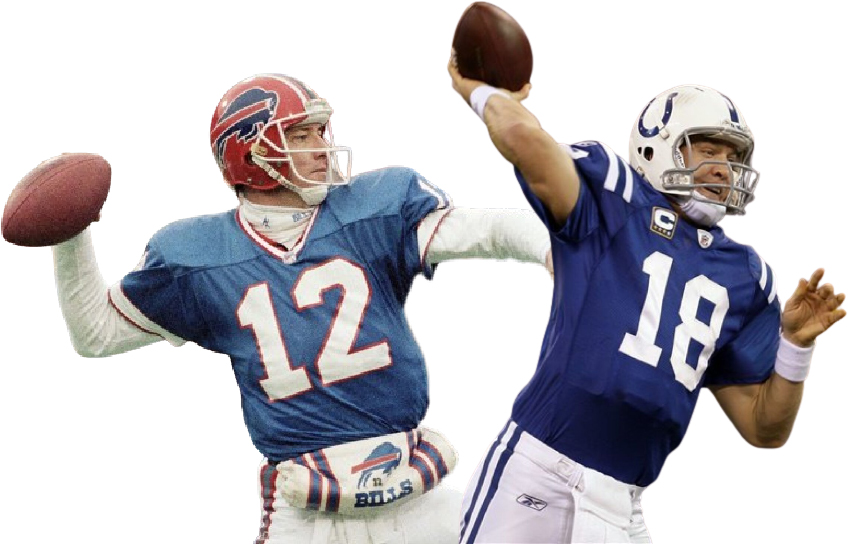
Notable examples: Peyton Manning, Jim Kelly
This is a distinct category because these guys are unique from the regular field generals, and not many QBs are like them.
Both of these guys, in their primes, had very strong arms. Both had good agility in the pocket. Peyton Manning was more of a pure pocket passer, Jim Kelly on the other hand was more mobile. The main thing they shared in common was the offense they ran: Both QBs ran up-tempo offenses with a heavy emphasis on making pre-snap audibles to find the perfect play to use against the defense. This led to their offenses being scary and their teams being perennial Super Bowl favorites, in their primes – but it led to post-season exits in which they underperformed, typically, relative to their regular season. Peyton Manning, despite being an excellent QB, still has a record for the most one-and-dones in the playoffs – and this includes home playoff games where his defense actually performed solidly. Similarly, Jim Kelly and his Buffalo Bills lost 4 straight Super Bowls – 2 of which were against teams that they had beaten in the regular season (1990, Giants, 1993, Cowboys) – although, their offense did not really perform worse in these games compared to the corresponding previous regular season matchup. They scored 13 against Dallas in both the regular season and playoffs. It was their defense that performed notably worse in these games. Granted, their offense still did drop off from the previous playoff games before the Super Bowl, and they turned it over more. And when you look at the games – namely Super Bowl 26 against Washington – you can see how flustered their offense was, with Kelly looking out of sorts.
It seems like the limiting factor is that with these offenses, the opposing defenses can telegraph the typical audibles the QB would call based on the look that the defense shows pre-snap. So teams can bait them and show a blitz look to bait the QB into audibling to some go-routes – but then after the snap, the safeties drop back, and confuse the QB, making them flustered. This is why if you even look at the facial expressions of Peyton and Kelly in some of these playoff games, they can look rattled.
Tom Brady
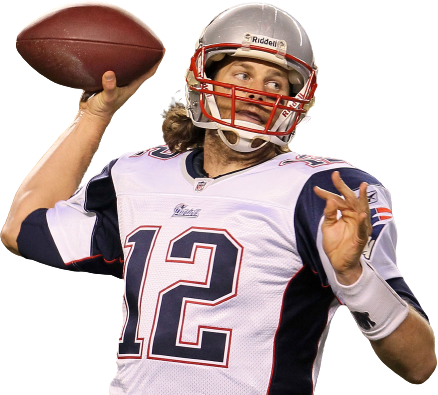
Closest Comp: Troy Aikman?
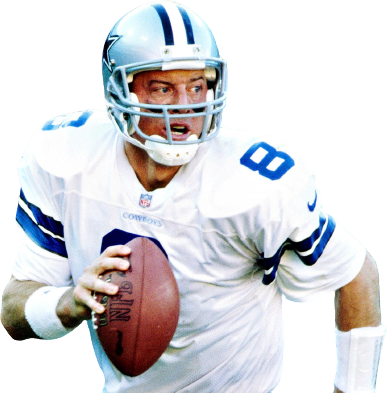
Tom Brady can’t really be put into a box. You could say he’s a field general – he will direct and lead the offense, make the right reads after understanding the defense, pre and post-snap. He has a fast processer. But again, a lot of QBs can technically be field generals. Brady is not afraid to be a (stiff) gunslinger though, and he typically can make difficult throws both in the intermediate range and also deep downfield, as he has a good arm, and can throw with great velocity when his feet are set. But he knows how to control himself. He can manage games, but if his team needs him to pass 35 times he can do it just fine. He can easily deliver when his team is down and the other team knows he’s going to pass. This is part of why he’s led so many comebacks in the playoffs. He knows when to be conservative and when to take risks. He’s not a fast runner at all, but is very nimble within the pocket, and has some of the best pocket presence ever. The few times he does take off to run, he can still get some 10 yards though. (And he’s also the best at QB sneaks, as well.)
His post-snap processing is probably the best of any QB ever, and is the true reason why he’s the GOAT. Brady is an obsessive film-watcher, and thus great at noticing defensive looks before the snap, which he occasionally accounts for by either audibling, changing routes, or assigning receivers/tight ends to block potential blitzers. But post-snap, Brady is very quick at processing defensive coverage, and knows where his guys are going to be. Combined with his pocket presence, oh yeah, and his incredibly consistent mechanics and really fast release, Brady is able to set his feet and make the right throw to his receivers, quickly. Brady is willing to throw into coverage, even to his number 3 and 4 receivers. This can occasionally result in incompletions (or occasionally interceptions), as they may not be on the same page. But this helps build chemistry with them.
This is also why he has strong poise, in the playoffs, despite his lack of extreme physical talent: the game doesn’t appear too fast for him, and he’s well prepared. So a strong defense can’t really shut him down, save for a few like the 2010 Jets and 2012 Ravens, who had generational defensive talent.
Where Troy Aikman is similar in that both of them – especially in the postseason – have strong poise, and are willing and able to make the tight throws needed against strong defensive coverage. This is why Aikman was excellent in the playoffs, and why Brady and his offenses have also held up well in the post season.

Here are some of Aikman’s best throws. You’ll notice some of them are in the playoffs:
Both guys are known for being great field generals, having fiery leadership, and being able to throw accurately into tight windows with high velocity when their feet are set.
Overall, Brady, when you watch him, doesn’t always wow you with highlight worthy plays. He’s just clinical and efficient, and incredibly consistent. He’ll have games where the offense just moves down field constantly in 7-10 play drives, as he makes the right reads with precision and timing. This is why he’s also architected some of the most productive offenses ever. Additionally, these offensive drives he leads are also good for burning the clock. This helps his team’s defenses, as the more his offense stays on the field, the more rested his defense is, and the more pressure there is on the opposing QB to keep up. And usually, they won’t.
Brady’s playstyle gives him a strong measure of consistency, and some large peaks in between – as proven by his 3 MVPS, and 3 MVP runner-ups. His willingness to throw into coverage may prevent him from having really high EPA/efficiency stats in some years. But in the playoffs – where it matters the most – there’s basically no other QB you’d rather have than Tom.
Conclusion
Well, there we have it. These are the QB archetypes. There generally can be some overlap between them (some of the stiff gunslingers can benefit from strong running backs like the Play Deception QBs), but overall, these groupings do a pretty decent job of discovering some new information about football they has been under our nose the whole time: that a QB’s physical talent tends to predict their playstyle, which tends to predict their circumstances and career success.
Do these archetypes make sense? Are they accurate? Let us know and leave a comment.


